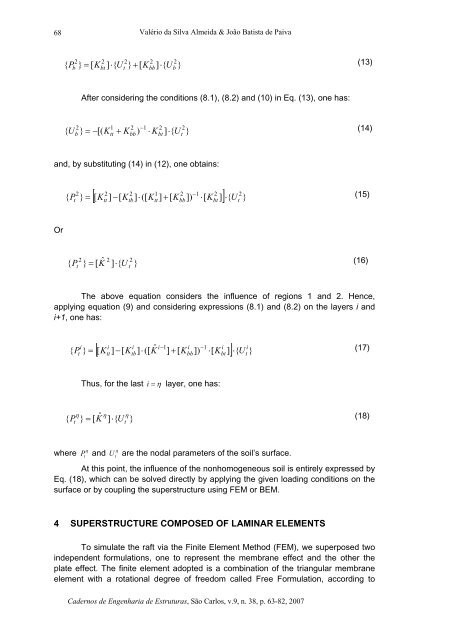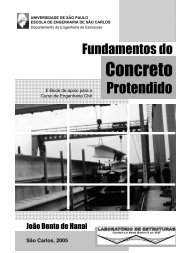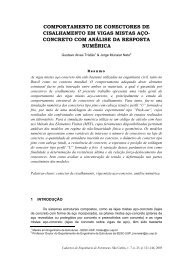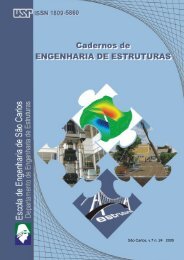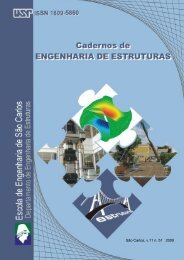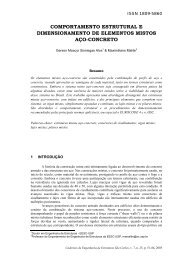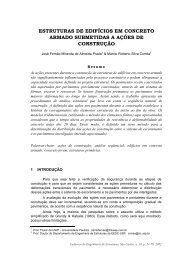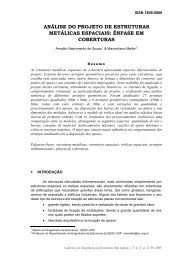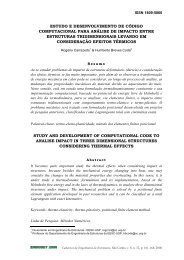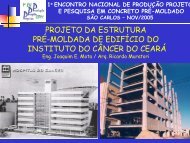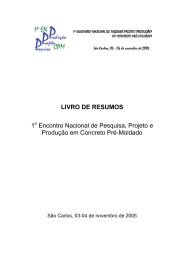download completo - SET - USP
download completo - SET - USP
download completo - SET - USP
You also want an ePaper? Increase the reach of your titles
YUMPU automatically turns print PDFs into web optimized ePapers that Google loves.
68<br />
Valério da Silva Almeida & João Batista de Paiva<br />
2<br />
b<br />
{ P<br />
2 2 2 2<br />
} = [ K ] ⋅{<br />
U } + [ K ] ⋅{<br />
U }<br />
(13)<br />
bt<br />
t<br />
bb<br />
b<br />
After considering the conditions (8.1), (8.2) and (10) in Eq. (13), one has:<br />
{ U<br />
2<br />
b<br />
} = −[(<br />
K<br />
1<br />
tt<br />
+ K<br />
2<br />
bb<br />
− 1 2 2<br />
) ⋅ K ] ⋅{<br />
U }<br />
(14)<br />
bt<br />
t<br />
and, by substituting (14) in (12), one obtains:<br />
2<br />
t<br />
{ P<br />
} =<br />
2 2 1 2 1 2 2<br />
[ K ] −[<br />
K ] ⋅ ([ K ] + [ K ]) ⋅[<br />
K ]] ⋅{<br />
U }<br />
tt<br />
tb<br />
tt<br />
bb<br />
− (15)<br />
bt<br />
t<br />
Or<br />
{ P<br />
ˆ 2 2<br />
} = [ K ] ⋅{<br />
}<br />
(16)<br />
2<br />
t U t<br />
The above equation considers the influence of regions 1 and 2. Hence,<br />
applying equation (9) and considering expressions (8.1) and (8.2) on the layers i and<br />
i+1, one has:<br />
i<br />
t<br />
{ P } =<br />
i i<br />
ˆ i 1 i −1<br />
i i<br />
[ K ] −[<br />
K ] ⋅ ([ K ] + [ K ]) ⋅[<br />
K ]] ⋅{<br />
U }<br />
tt<br />
tb<br />
− (17)<br />
bb<br />
bt<br />
t<br />
Thus, for the last<br />
i = η layer, one has:<br />
{ P<br />
ˆ η η<br />
} = [ K ] ⋅{<br />
}<br />
(18)<br />
η<br />
t U t<br />
η<br />
η<br />
where P<br />
t<br />
and U<br />
t<br />
are the nodal parameters of the soil’s surface.<br />
At this point, the influence of the nonhomogeneous soil is entirely expressed by<br />
Eq. (18), which can be solved directly by applying the given loading conditions on the<br />
surface or by coupling the superstructure using FEM or BEM.<br />
4 SUPERSTRUCTURE COMPOSED OF LAMINAR ELEMENTS<br />
To simulate the raft via the Finite Element Method (FEM), we superposed two<br />
independent formulations, one to represent the membrane effect and the other the<br />
plate effect. The finite element adopted is a combination of the triangular membrane<br />
element with a rotational degree of freedom called Free Formulation, according to<br />
Cadernos de Engenharia de Estruturas, São Carlos, v.9, n. 38, p. 63-82, 2007


